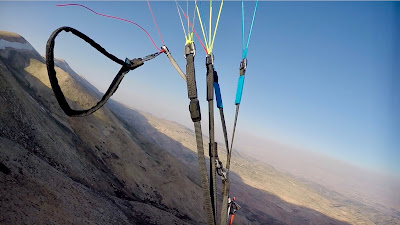ADVANCE Sigma 10 25 (Authenticity at it’s best)
Here’s the new Sigma…How times go fast…I still remember my flights on the Sigma 4, 19 years ago !!!! high above ‘Cheval blanc’ in Saint Andre…Conditions were rough! was a bit lost… heavy turbulence…Great memories ;-)
But that glider turned on a dime ! It was a dhv 2-3 at the time, and was pretty dynamic in frontals, but what a dream handling it had!
Back to the future now, with the Sigma 10 in size 25 ready to take off finally. As usual, the construction, the sewings, the finishing details of the Sigma 10 is similar to a Ferrari. Don’t expect less.
Launching the 6.1 aspect ratio Sigma 10 is smooth, easy, and without surprises. The take off is immediate.
First turn and my eyebrows are already lifted! The brake travel is very responsive, accurate, precise, direct, and linear. Much better progressive feel over the S9. I flew the Sigma 10 in different conditions, from the sea spots to the higher Cedars range, and i never felt anytime that it was reluctant to turn in any kind of thermic conditions. The Sigma 10 responded to my commands whenever i wanted regardless of what conditions is around. A super obedient glider and a pleasurable one to fly. It can be placed exactly where the pilots wants.
This excellent brake authority is coupled with a very well structured glider. Whatever it is…optimized Sliced Diagonals, 3D Diamond Shaping, C-Wires…I really don’t know, but i’m very sure that the internal structure of this Sigma 10 is super solid, super coherent, and very efficient in turbulent air. I didn’t noticed any wrinkles on that surface…It seems flawless…Or i could be getting old and needs glasses ;-)
i flew the Sigma 10 ,25 from 93 to 97 and it was the optimum weight for any kind of conditions. This coherent solid feel was always present like a guardian.
I also flew next to my reference glider in the C category, the Cayenne 5 XS at 92 all up. Doing many glides in active air together showed at first a similar glide at trim speed with a very slight edge in trim speed for the S10. The difference was more visual at 40 % of the Sigma 10, red marker. At that speed, with the Cayenne 5 XS matching it also, the Sigma 10 showed me a better glide by a small margin in calm air. In active turbulent air this margin was bigger. For me it was a first. Not one C glider before yet out-glided the cayenne 5.
Full speed on the Cayenne 5 with the Sigma 10 matching that speed, they showed same glide again. Now the Sigma 10 similarly loaded has +3km/h more top speed. Pushing that speed in front of the Cayenne 5 for a while and releasing it. When the Cayenne 5 reached the Sigma 10, they were again at the same level.
The best glide for the Sigma 10, size 25 is around 40 % over trim !
Climb rate in weak condition less than 0.5 m/s were slightly on the Cayenne 5 which seems slightly a bit floatier. As the thermal are more punchy and powerful, the Sigma 10 shoots quickly upward! It’s a 6.1 AR, but it does really go up very fast reaching the top of gaggles.
I noticed that each time the conditions were more turbulent, the Sigma 10, showed more it’s potential by cutting through and moving forward like no Sigma has done before. That’s why, i can confirm swiftly that this Sigma 10 is the best Sigma ever made when it comes to true performance!
Wait…That’s not all .. :-)
The Sigma 10 delivers a high comfort in active air ! This swift handling, the solid structure, will let the C pilot control it swiftly and accurately in active air. I can say any Good B pilot could easily upgrade on the Sigma 10 after two seasons on his glider. At it’s optimum weight load, this profile doesn’t pitch back in turbulence, neither forward. It just goes trough turbulence and move forward, letting it’s pilot comfortably relaxed. It’s an efficient glider in headwind or valley breeze, especially for 6.1 AR C glider. I’ll update my C comparison soon, but be prepared to see the Sigma 10 among the most comfortable ones.
There’s one more :-)
The Sigma 10 has one of the most efficient C controls a glider can have. It doesn’t react as a 2 liner, but really close :-) .
I mean this glider is much more stable than higher rated ones, therefore, when on bar, this efficient C control, will help a lot by reducing any surge movement in active air. So stepping on the pedal is very easy and accessible.
Big ears with outer A’s move slightly but i can say they are stable enough and reopen by a small dab on the brakes or sometimes calmly by themselves. Big ears pulling the B3 and the stabile line works well also, but it’s better for this method to push the bar before pulling them. They reopen swiftly!
Conclusion: Advance has done a marvelous job on this Sigma 10! They didn’t stretch the aspect ratio, keeping it simple and authentic as it should be. They worked hard on the inner structure and other details and they succeeded to deliver accessible ‘TOP’ performance in the C category. 1- 90% Comfortable, 2- 95% agile, 3- 90% efficient and usable top performance, plus fast enough for a C !
Happiness emerges from the most simple things in life. The Sigma 10 approaches that philosophy with excellence.
Fly safe,
Ziad














